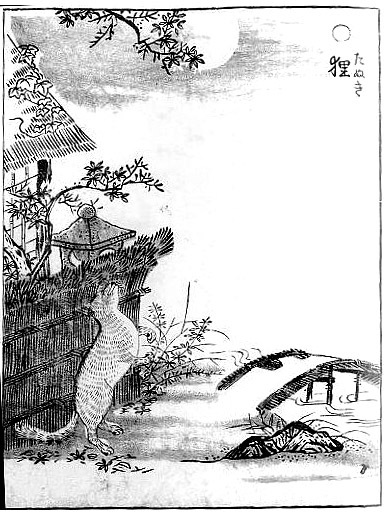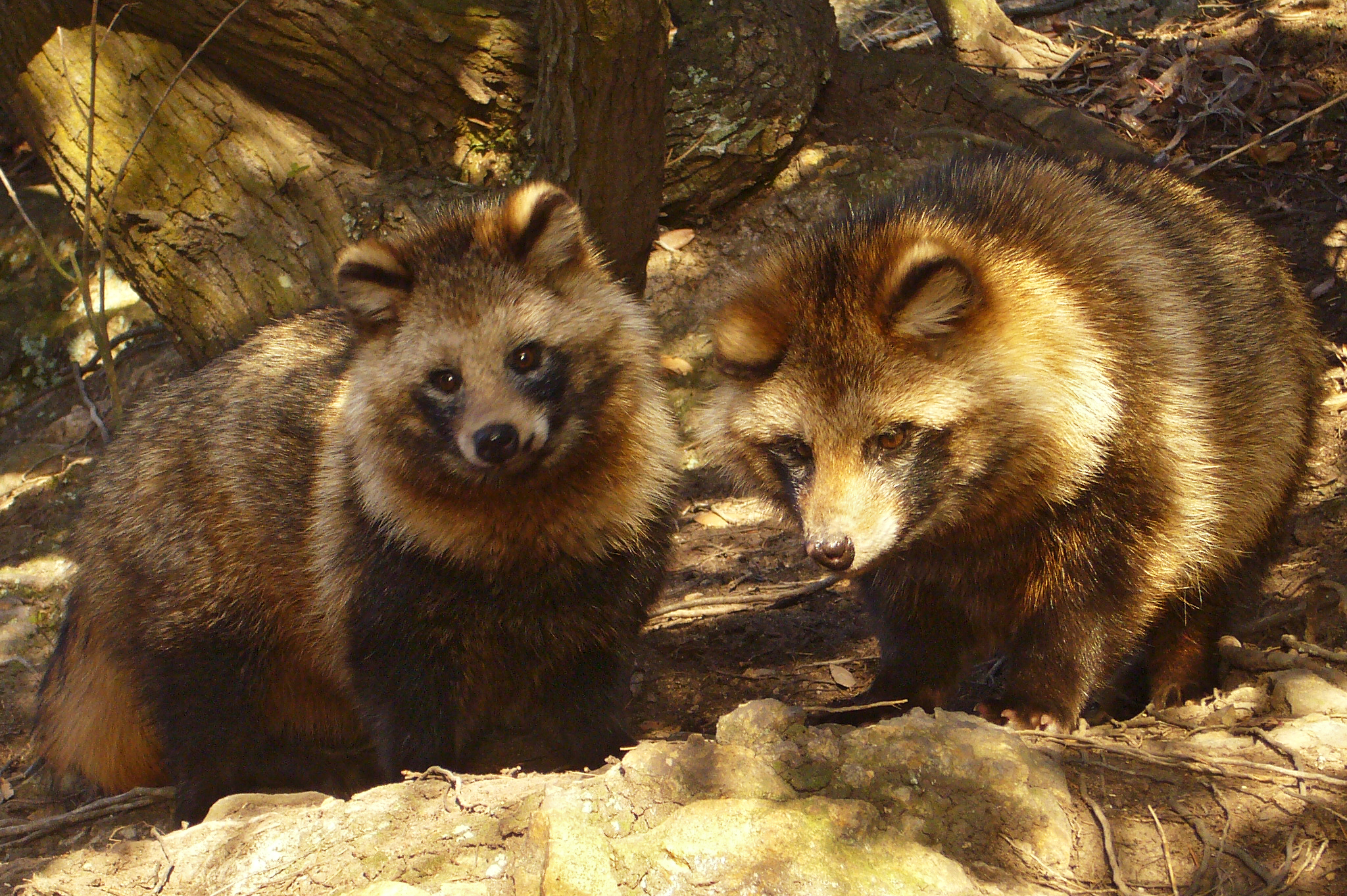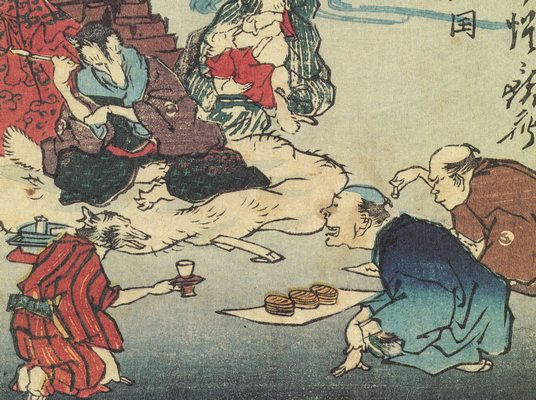|
Bake-danuki
''Bake-danuki'' () are a kind of ''yōkai'' (supernatural beings) found in the classics and in the folklore and legends of various places in Japan, commonly associated with the Japanese raccoon dog or ''tanuki''. Although the ''tanuki'' is a real, extant animal, the ''bake-danuki'' that appears in literature has always been depicted as a strange, even supernatural animal. The earliest appearance of the ''bake-danuki'' in literature, in the chapter about Empress Suiko in the '' Nihon Shoki'' written during the Nara period, there are such passages as "in two months of spring, there are tanuki in the country of Mutsu (), they turn into humans and sing songs ()." Bake-danuki subsequently appear in such classics as the Nihon Ryōiki and the Uji Shūi Monogatari. In some regions of Japan, ''bake-danuki'' are reputed to have abilities similar to those attributed to ''kitsune'' (foxes): they can shapeshift into other things or people, and can possess human beings. Many legends of ''tanuk ... [...More Info...] [...Related Items...] OR: [Wikipedia] [Google] [Baidu] |
Japanese Raccoon Dog
The Japanese raccoon dog (''Nyctereutes viverrinus''), also known as the ''tanuki'' ( ja, , , ), is a species of canid endemic to Japan. It is one of two species in the genus ''Nyctereutes'', alongside the common raccoon dog (''N. procyonoides''), of which it was formerly thought to be a subspecies. The Japanese raccoon dog has a relatively smaller stomach and shorter fur of lesser insulation value than mainland raccoon dogs. A rare, white colour type can also be found. Within Japanese folklore, the ''tanuki'' have had a significant role since ancient times. The legendary ''tanuki'' are reputed to be mischievous and jolly, masters of disguise and shapeshifting but somewhat gullible and absentminded. The animals have also been common in Japanese art, particularly as subjects for statues. Japanese etymology While ''tanuki'' are prominent in Japanese folklore and proverbs, they were not always clearly distinguished from other animals with a similar appearance. In local dialects, '' ... [...More Info...] [...Related Items...] OR: [Wikipedia] [Google] [Baidu] |
Awa Tanuki Gassen
The (also called the or the ) is a Japanese legend that takes place in the Awa Province (now Tokushima Prefecture). The legend is about a great war between two ''tanuki ''powers. There are several well-known tales about tanuki in Shikkoku, and this one is said to be the most famous among those from Tokushima. This story first appeared near the end of the Edo Period, and in literature, it was first published in Meiji 43 (1910) under the title "Shikoku Kidan Jissetsu Furudanuki Gassen" (四国奇談実説古狸合戦). It was a kōdan from the Meiji period until the time of the war and gained popularity in the beginning of the Showa period as it became depicted in movies. In the Heisei period, it has become a common theme in community development and is widely known in Tokushima Prefecture. Legend The story took place around the tenpō period (from 1830 to 1844) near Higaino in Komatsushima (now Higaino-chō in the city of Komatsushima, Tokushima). A dyer named Moemon (茂右� ... [...More Info...] [...Related Items...] OR: [Wikipedia] [Google] [Baidu] |
Kachi-kachi Yama
, also known as ''Kachi-Kachi Mountain'' and ''The Farmer and the Badger'', is a Japanese folktale in which a ''tanuki'' (Japanese raccoon dog) is the villain, rather than the more usual boisterous, well-endowed alcoholic. Story The trouble-making ''tanuki'' As the story goes, a man caught a troublesome ''tanuki'' in his fields, and tied it to a tree to kill and cook it later. When the man left for town, the ''tanuki'' cried and begged the man's wife who was making some ''mochi'', a sweet rice dish, to set him free, promising he would help her. The wife freed the animal, only to have it turn on her and kill her. The ''tanuki'' then planned a foul trick. Using its shapeshifting abilities, the ''tanuki'' disguised itself as the wife and cooked a soup, using the dead woman's flesh. When the man came home, the ''tanuki'' served him the soup. After the meal, the ''tanuki'' reverted to its original appearance and revealed its treachery before running off and leaving the poor man in s ... [...More Info...] [...Related Items...] OR: [Wikipedia] [Google] [Baidu] |
Danzaburou-danuki
is a bake-danuki passed down in stories on Sado Island, particularly in Aikawa and Niigata. In Sado, tanuki were called "mujina (狢)", thus he was also referred to as Danzaburou-mujina (団三郎狢). In the Ukiyo-e, its name was written as 同三狸." Together with the Shibaemon-tanuki of Awaji Island, and the Yashima no Hage-tanuki of Kagawa, they form the " three famous tanuki" of Japan. Legend The supreme commander of the tanuki on Sado Island, most tales of Danzaburou focus on his trickery of humans. He would create wall-like structures to block people's paths at night, fooled people with mirages and sold leaves from trees by making them look as if they were made of gold. He also created mirages to lure people into his lair (said to be a hole in the ground or a cellar), making it appear as a splendid estate. If he ever became ill, Danzaburou would disguise himself as a human and visit human doctors for treatment. His reputation was not all bad, however. He was said to ha ... [...More Info...] [...Related Items...] OR: [Wikipedia] [Google] [Baidu] |
Japanese Badger
The Japanese badger (''Meles anakuma'') is a species of carnivoran of the family Mustelidae, the weasels and their kin. Endemic to Japan, it is found on Honshu, Kyushu, Shikoku, and Shōdoshima. It shares the genus '' Meles'' with its close relatives, the European (''M. meles'') and Asian (''M. leucurus'') badgers. In Japan it is called by the name ''anaguma'' (穴熊) meaning "hole-bear", or ''mujina'' (むじな, 狢). Description Japanese badgers are generally smaller (average length in males, in females) and less sexually dimorphic (except in the size of the canine teeth) than their European counterparts. Tail length is between . This species is similar or mildly larger than the Asian badger. Adults usually weigh from . The average weight of female Japanese badgers in one study from the Tokyo area was found to be while that of males was . In the Yamaguchi Prefecture, the average spring weight of female and male Japanese badgers was and .Tanaka, H. 2002. ''Ecology and So ... [...More Info...] [...Related Items...] OR: [Wikipedia] [Google] [Baidu] |
China
China, officially the People's Republic of China (PRC), is a country in East Asia. It is the world's most populous country, with a population exceeding 1.4 billion, slightly ahead of India. China spans the equivalent of five time zones and borders fourteen countries by land, the most of any country in the world, tied with Russia. Covering an area of approximately , it is the world's third largest country by total land area. The country consists of 22 provinces, five autonomous regions, four municipalities, and two Special Administrative Regions (Hong Kong and Macau). The national capital is Beijing, and the most populous city and financial center is Shanghai. Modern Chinese trace their origins to a cradle of civilization in the fertile basin of the Yellow River in the North China Plain. The semi-legendary Xia dynasty in the 21st century BCE and the well-attested Shang and Zhou dynasties developed a bureaucratic political system to serve hereditary monarchies, or dyna ... [...More Info...] [...Related Items...] OR: [Wikipedia] [Google] [Baidu] |
Leopard Cat
The leopard cat (''Prionailurus bengalensis'') is a small wild cat native to continental South, Southeast, and East Asia. Since 2002 it has been listed as Least Concern on the IUCN Red List as it is widely distributed although threatened by habitat loss and hunting in parts of its range. Historically, the leopard cat of continental Asia was considered the same species as the Sunda leopard cat. As of 2017, the latter is recognised as a distinct species, with the taxonomic name ''Prionailurus javanensis''. Leopard cat subspecies differ widely in fur colour, tail length, skull shape and size of carnassials. Archaeological evidence indicates that the leopard cat was the first cat species domesticated in Neolithic China about 5,000 years ago in Shaanxi and Henan Provinces. Characteristics A leopard cat is about the size of a domestic cat, but more slender, with longer legs and well-defined webs between its toes. Its small head is marked with two prominent dark stripes and a s ... [...More Info...] [...Related Items...] OR: [Wikipedia] [Google] [Baidu] |
Wild Boar
The wild boar (''Sus scrofa''), also known as the wild swine, common wild pig, Eurasian wild pig, or simply wild pig, is a suid native to much of Eurasia and North Africa, and has been introduced to the Americas and Oceania. The species is now one of the widest-ranging mammals in the world, as well as the most widespread suiform. It has been assessed as least concern on the IUCN Red List due to its wide range, high numbers, and adaptability to a diversity of habitats. It has become an invasive species in part of its introduced range. Wild boars probably originated in Southeast Asia during the Early Pleistocene and outcompeted other suid species as they spread throughout the Old World. , up to 16 subspecies are recognized, which are divided into four regional groupings based on skull height and lacrimal bone length. The species lives in matriarchal societies consisting of interrelated females and their young (both male and female). Fully grown males are usually solitary ... [...More Info...] [...Related Items...] OR: [Wikipedia] [Google] [Baidu] |
Japanese Giant Flying Squirrel
The is a species of flying squirrel, one of the giant flying squirrels in the genus ''Petaurista''. Description Like other flying squirrels, it has a web of skin between its legs which it uses to glide between trees. Glides of 160 metres have been recorded. The tail is used for stability during flight. The body is about 25–50 cm long, and the tail a further 30–40 cm. It weighs between 700 and 1500g. It is much larger than the related Japanese dwarf flying squirrel which does not exceed 220g. It eats fruit and nuts and lives in holes in large trees. The female has a home range of about a hectare and the male about two hectares. Distribution and habitat It is native to Japan, where it inhabits sub-alpine forests and boreal evergreen forests on the islands of Honshu, Shikoku and Kyushu. Reproduction Sexual maturity is reached after about two years. From winter to early summer the males compete for females. During mating, after ejaculation, the male produces a ... [...More Info...] [...Related Items...] OR: [Wikipedia] [Google] [Baidu] |
Weasel
Weasels are mammals of the genus ''Mustela'' of the family Mustelidae. The genus ''Mustela'' includes the least weasels, polecats, stoats, ferrets and European mink. Members of this genus are small, active predators, with long and slender bodies and short legs. The family Mustelidae, or mustelids (which also includes badgers, otters, and wolverines), is often referred to as the "weasel family". In the UK, the term "weasel" usually refers to the smallest species, the least weasel (''M. nivalis''), the smallest carnivoran species. Least weasels vary in length from , females being smaller than the males, and usually have red or brown upper coats and white bellies; some populations of some species moult to a wholly white coat in winter. They have long, slender bodies, which enable them to follow their prey into burrows. Their tails may be from long. Weasels feed on small mammals and have from time to time been considered vermin because some species took poultry from far ... [...More Info...] [...Related Items...] OR: [Wikipedia] [Google] [Baidu] |
Kagawa Prefecture
is a prefecture of Japan located on the island of Shikoku. Kagawa Prefecture has a population of 949,358 (as of 2020) and is the smallest prefecture by geographic area at . Kagawa Prefecture borders Ehime Prefecture to the southwest and Tokushima Prefecture to the south. Takamatsu is the capital and largest city of Kagawa Prefecture, with other major cities including Marugame, Mitoyo, and Kan'onji. Kagawa Prefecture is located on the Seto Inland Sea across from Okayama Prefecture on the island of Honshu, which is connected by the Great Seto Bridge. Kagawa Prefecture includes Shōdoshima, the second-largest island in the Seto Inland Sea, and the prefecture's southern land border with Tokushima Prefecture is formed by the Sanuki Mountains. History Kagawa was formerly known as Sanuki Province. For a brief period between August 1876 and December 1888, Kagawa was made a part of Ehime Prefecture. Battle of Yashima Located in Kagawa's capital city, Takamatsu, the mounta ... [...More Info...] [...Related Items...] OR: [Wikipedia] [Google] [Baidu] |





.jpg)

.jpg)